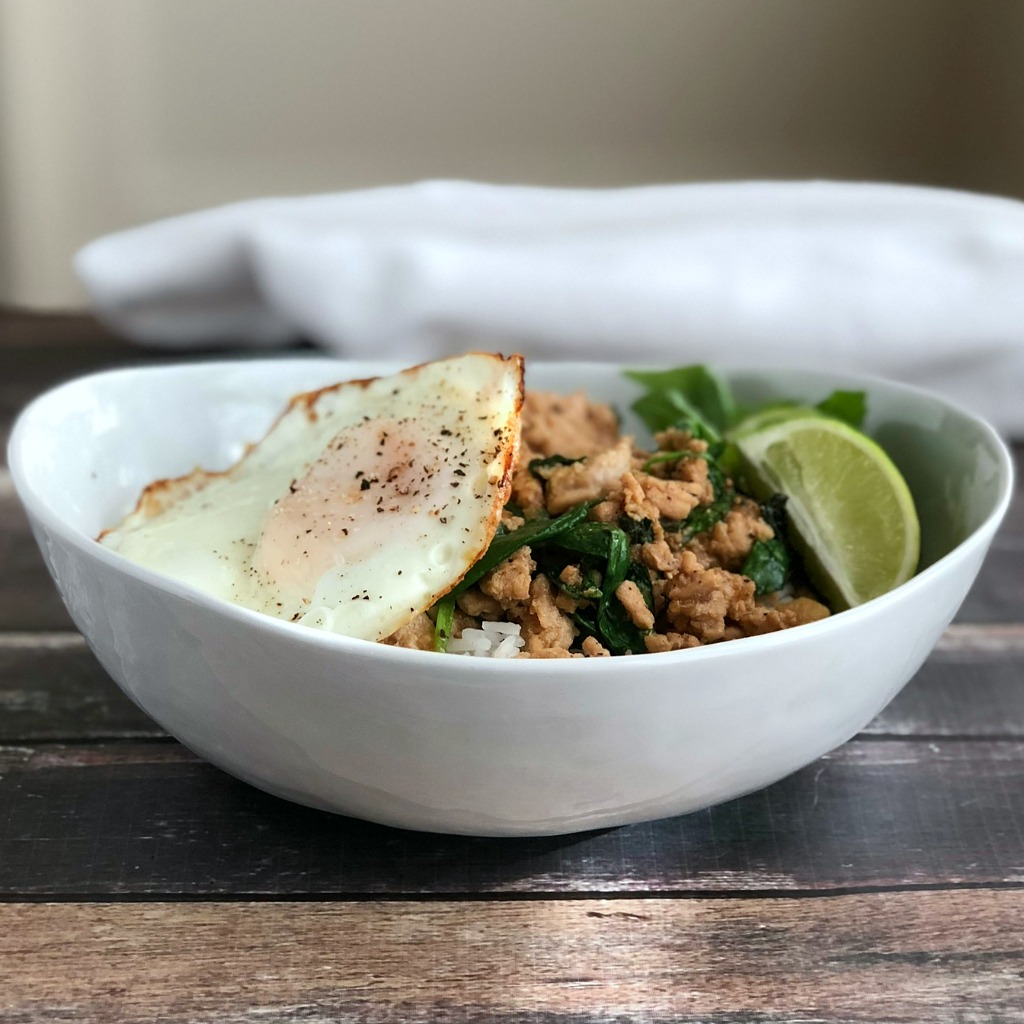
Basil Thai Chicken with Fried Eggs & Rice
This recipe is adapted from a scribbled-upon version of Leela Punyaratabandhu’s script for “Spicy Basil Chicken and Fried Eggs on Rice” (or “khao rat phat ka-phrao kai khai dao”) from her mouthwatering cookbook Simple Thai Food. The scribbles are from a dear friend (the cookbook gifter) as she promised to ease me into her world of everyday Thai cooking and provide an even simpler approach. And, her edits are based upon the influence of her friend, a Thai woman with whom she’s cooked many unforgettable meals. Lots of love, tradition, camaraderie, and experience went into this recipe, and it definitely tastes that way.

- 1.5 c. long-grain rice (white or brown), uncooked
- 5 large or 8 small garlic cloves, peeled and halved
- 1-3 green or red chiles coarsely chopped (see TIP A below)
- 1 medium shallot, coarsely chopped
- 2 tbsp. vegetable oil
- 4 eggs
- 1.5 lbs. ground chicken or turkey
- 1 tbsp. fish sauce
- 3 tbsp. soy sauce
- 1.5 tbsp. oyster sauce
- 1/2 to 2/3 c. low-sodium chicken broth or stock
- 5 oz. fresh baby spinach leaves
- 1 c. fresh Thai basil or sweet basil leaves (see TIP B below)
- 1 lime, cut into wedges
- Kosher or flake sea salt and fresh ground black pepper, to taste
-
Prepare the rice according to the instructions on the back of pack or your own tried-and-true technique (a.k.a. rice cooker). Do not add butter or oil as indicated by some varieties.
-
Combine the first 3 ingredients (garlic, chiles, and shallot) in a mini food processor or blender and whir until all pieces are very finely minced. Set aside.
-
In a large skillet or cast-iron pan, warm the vegetable oil until it moves easily around the bottom of the pan and/or appears to ripple slightly when at rest. Then carefully crack each egg into the pan leaving a bit of room between the whites if possible. Cook the eggs to your liking, but at least long enough for the whites to fully set and become a bit brown and crispy around the edges. You can put a piece of aluminum foil over the pan to minimize the splatter of oil and help the top of the eggs set. Once done, remove the eggs from the pan and set them aside. Reserve the oil in the pan.
-
Return the pan with the reserved oil to the stovetop over medium heat (if not already there). Add the prepared garlic-chile paste from Step Two. Give the paste a quick stir in the oil and then immediately add the ground chicken or turkey to prevent the paste from burning. Using a firm spatula or spoon, break the ground chicken or turkey into bits while at the same time mixing it with the paste. Let the chicken or turkey cook for 2-3 minutes, stirring occasionally.
-
Add the fish sauce, soy sauce, oyster sauce, and 1/2 cup broth to the pan and stir to coat the bits of ground chicken or turkey. Let the ingredients simmer and come together for an additional 5-7 minutes or until the chicken or turkey is cooked through. Add more broth if needed.
-
Once the chicken or turkey is cooked through, turn the heat beneath the pan to low and stir in the baby spinach and basil leaves. Work in batches if needed—the spinach and basil will seem like a lot going into the pan, but they cook down significantly. Once you've added all of the spinach and basil, turn off the heat and continue to stir until the leaves are fully wilted and coated with sauce. Then transfer the mixture to 4 bowls or plates each prepared with a bed of rice (be sure to give each portion a generous spoonful of sauce). Top each portion with a fried egg, 1-2 lime wedges, and a finishing sprinkle of kosher or flake sea salt and fresh ground black pepper (do not skip this step). Enjoy!
TIP A: The type and quantity of chiles that you use is entirely a matter of preference. Leela Punyaratabandhu's original recipe calls for 5-6 bird's eye chiles (small red or green chiles traditionally used in Thai cooking). For me, this is too much heat, so I opt for 3 of the bird's eye variety or 3 slightly more mild green chiles. You could also use a seeded Fresno chile if you want something even more mild. I do not recommend omitting the chiles entirely—they add a unique flavor that does not need to be hot, hot, hot if you use a less potent variety and amount.
TIP B: Perhaps you've seen Thai basil in your local grocery store and wondered what it's all about. It has a slightly more anise-like flavor than sweet basil and distinctly smaller leaves. It's probably my first choice for this recipe, but it can be hard to come-by. If you can't find Thai basil in your grocery store or market, then sweet basil is a perfect substitute.

Danny Schuman · May 02, 2018
This looks awesome! I might have to go sans oyster sauce since I can’t do shellfish. I assume soy sauce is an OK replacement? Any other suggestions?
off-script recipes · May 02, 2018
Yes, add a bit more soy sauce, but more as a sub for the fish sauce (beware of that as well if shellfish is a no-no). You may want to explore using both light (thin) and dark soy sauce for a bit more complexity of flavor. The oyster sauce lends some sweetness and thickness to the sauce, so I recommend adding a bit of brown sugar and corn starch if you omit it. Let me know how it goes and enjoy!